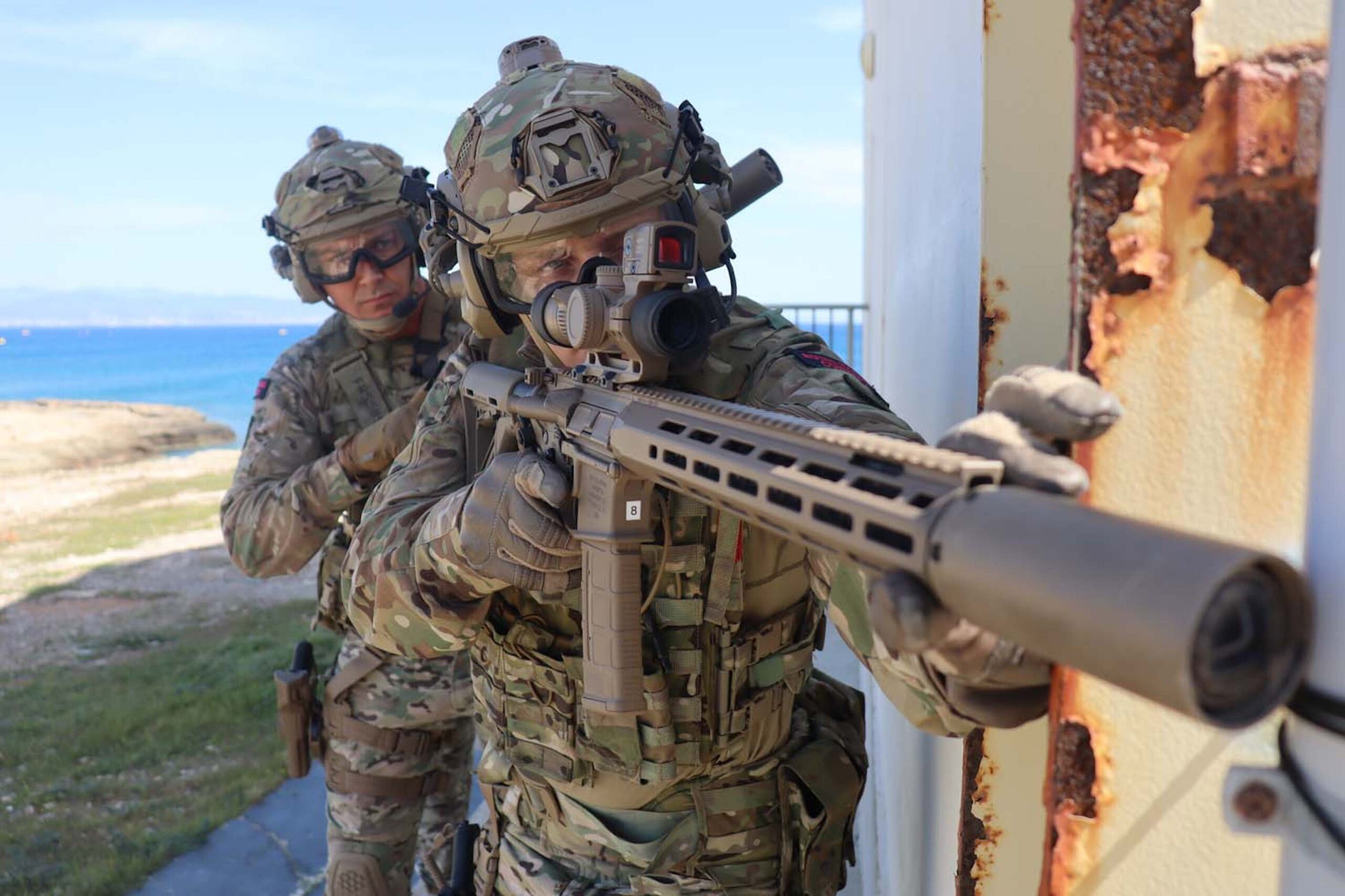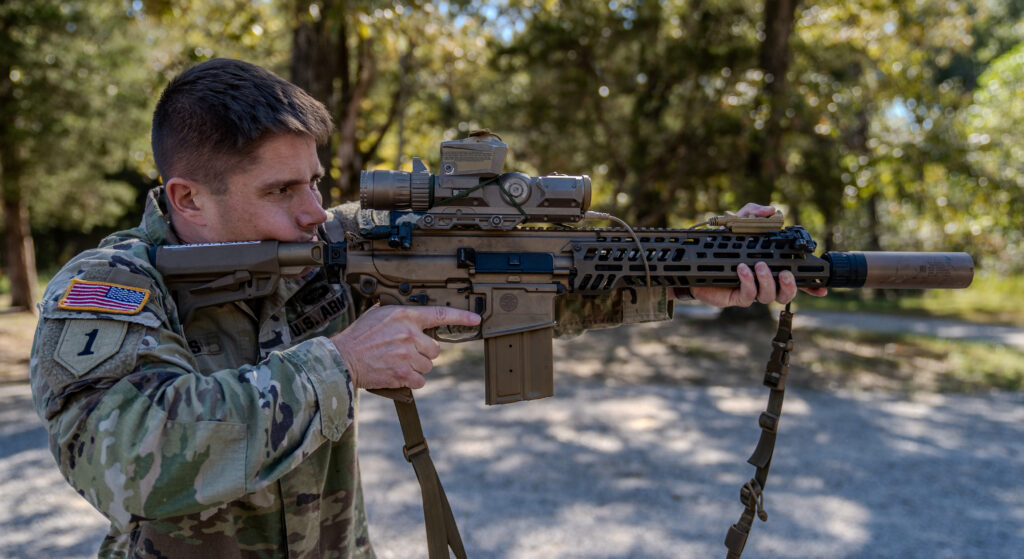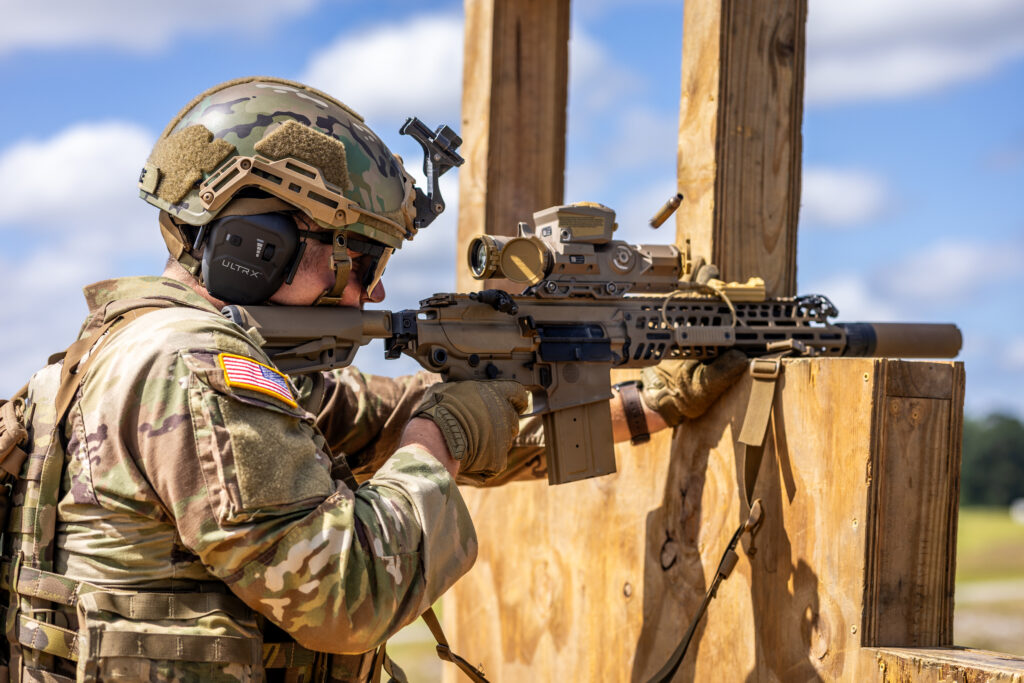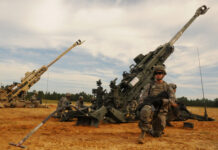
Small arms sights and fire control systems developments
David Saw
The small arms sector is undergoing a significant transformation, with a growing focus on integrating advanced fire control systems (FCS). This shift is poised to reshape the future of weaponry, as users increasingly seek to enhance the effectiveness and precision of small arms systems.
The problem is that while most agree some form of optic is essential, the reality is that far too many forces still have the majority of their infantry using iron sights; this is because not enough optics have been purchased or because the new rifles that they were to be integrated with are still in the process of delivery.
For example, it is not unusual to see French troops on the anti-terrorism mission in Paris equipped with the new Heckler & Koch (HK) HK416F rifles. Although the old FAMAS rifle can still be seen, the new rifle is increasingly prevalent. While the optic selected by the French Army is the Aimpoint CompM5, it is significant that many of the rifles with units deployed in Paris still lack this optic. The first deliveries of the weapon took place in May 2017, and the number of HK416F/HK416F-C rifles will reach 94,000 by the end of 2025, with all 117,000 rifles due to be delivered by 2028. Conceivably, the lack of optics on many deployed HK416F weapons reflects the extended delivery schedule of the French rifles, although it would have been reasonable to expect rifles and optics to be deployed in parallel.
One assault rifle programme placing emphasis on rapid delivery is the British Army Alternative Individual Weapon (AIW) programme, also known as Project Hunter. An Invitation to Tender (ITT) for the procurement and support of an Armalite Rifle (AR) platform Alternative Individual Weapon (AIW) System for the Army Special Operations Brigade (ASOB) and selected Royal Marine Commando units was issued in December 2021. Total fleet requirement for the AIW will eventually be in the region of 10,000 weapons. The ITT stated that “the AIW system will be a 5.56 mm Armalite Rifle (AR) platform, optimised for use with L15A2, a 62gr 5.56 × 45 mm NATO ball round, equivalent to SS109.”
The AIW is not just a rifle acquisition; the outline technical requirement was that it must be optimised for use with a suppressor and that the system would consist of a rifle plus signature reduction system and an optic system. This is the clear trend for the future in terms of small arms programmes of this nature – an optic and/or a suppressor are no longer an add-on to be acquired after the weapon is selected, as they are included in the selection process from the start. It marks a transition from accessory to essential for these systems. Amongst the suppliers sent the AIW ITT were potential rifle suppliers, such as: Caracal, Colt Canada, Daniel Defense, HK, Knight’s Armament Company (KAC), SIG Sauer and Steyr. Potential optic suppliers were Aimpoint, EOTech, Holosun, L3Harris, Leupold, Raytheon ELCAN, Steiner, Trijicon and Vortex Optics.

Winning solutions
The AIW programme came to a conclusion rapidly; as previously noted, the ITT was issued in December 2021, and by September 2023 the contract was awarded, less than two years later. The contract was awarded by the Soldier, Training & Special Projects team of Defence Equipment & Support (DE&S) of the Ministry of Defence (MOD). An initial order was placed for 1,620 weapons with a value of GBP 15 million, with the total requirement for up to 10,000 weapons valued at GBP 90 million over the following ten years. The first AIW rifles were delivered before the end of 2023.
The prime contractor was the Edgar Brothers company, whose AIW solution was based on the Knight’s Armament Company (KAC) KS-1 5.56 × 45 mm rifle, KAC also call this the SR-16 for ‘Stoner Rifle’. The weapon is now designated as the L403A1 in British Service. The weapon is also fitted with a KAC MCQ-PRT suppressor, with Magpul providing PMAG magazines, the pistol grip, grip stock and other accessories. As might be expected, the rifle is equipped with ample rail systems to attach further accessories as required. Notably the new rifle, with all of its add-ons, still weighs less than the current L85A2 and L85A3 in-service rifles. The optics solution selected for the AIW is classified as the L900A1 Optics Suite. This consists of a Vortex Optics 1-10x LPVO on a Reptilla AUS mount, with an Aimpoint ACRO-2 red dot sight on a Reptilla ROF 90 mount.
All things considered, the AIW programme shows that it is possible to issue an ITT, evaluate the responses, conduct an effective test programme with the weapons submitted for trials, make a final decision and award an acquisition contract rapidly. Life could have been much simpler for DE&S and the British Army if they had just selected the standard US M4 carbine and purchased on a government-to-government basis, in parallel they could have purchased the optics suite and the various other add-ons direct. This approach was rejected, and instead the most effective rifle has been selected, along with optics and other add-ons, that best meet British requirements. With Edgar Brothers assembling the complete AIW package, with its L900A1 Optics Suite, at their Macclesfield, Cheshire facility in Northern England.

At the time of the announcement it was stated that 118,718 rifles would be procured, these would be the HK416A8 which will be acquired in two variants: the G95A1 with a 16.5 inch barrel and a carbine variant, the G95KA1, with a 14 inch barrel. German Special Forces were already using the HK416A7 which is designated as the G95. The System Sturmgewehr contract was signed in January 2023, with an initial order being placed for 13,929 G95A1 and 3,104 G95KA1. In addition, 40 rifles were acquired for qualification testing, with another 350 rifles acquired for troop trials including testing in different environments, such as Yuma in the US for desert conditions and Panama for tropical conditions, with these trials commencing in January 2024. Target introduction to service of the G95A1/G95KA1 with the Bundeswehr is in 2026.
It does seem that they are taking their time in bringing the G95A1/G95KA1 into service, and nobody can doubt the need for in-depth testing, but it’s not as if these weapons are that fundamentally different from the G95, which is in service with the German Special Forces. Presumably these went through an in-depth test programme before being taken into service? An interesting point is that these trials in the US apparently saw other optics used in addition to the Specter DR, supposedly to check compatibility with the G95A1/G95KA1. This does seem odd — after all, the HK416 must have been integrated with all of the major optics systems currently available over the years. Are they having second thoughts on optics or just attempting to cover all the bases in their testing programme?
American future
The British and German programmes provide two examples of how different users go about selecting a new weapon and optic; it comes down to the opinion of the new users of the rifle and optic as to which selection and acquisition approach is better. There is, of course, a different approach to all of this and that was the approach selected by the US. Selecting a new service rifle has consistently proved to be a complex prospect for the US military. The current effort started in June 2017 with the Interim Combat Service Rifle (ICSR), which was halted in November 2017; later, a new programme emerged in the form of the Next Generation Squad Automatic Rifle (NGSAR).

The Next Generation Squad Weapons – Fire Control (NGSW-FC) system was competed separately, with two companies selected for the final downselect in the form of L3Harris and Vortex Optics. In January 2022, it was announced that Vortex Optics had been selected for the XM157 NGSW-FC system requirement. According to the US Army: “The XM157 integrates a number of advanced technologies, including a variable magnification optic (1-8×30), backup etched reticle, laser rangefinder, ballistic calculator, atmospheric sensor suite, compass, Intra-Soldier Wireless, visible and infrared aiming lasers, and a digital display overlay.” Vortex Optics could provide as many as 250,000 XM157 NGSW-FC systems through 2032, with contract value estimated at some USD 2.7 billion. The NGSW-FC will also be linked with the US Army Integrated Visual Augmentation System (IVAS).
The 6.8 × 51 mm Common Cartridge provides greatly enhanced range, accuracy and lethality than current standard 5.56 × 45 mm and 7.62 × 51 mm rounds; the NGSW-FC further enhances the accuracy and range of the XM7 and XM250. It’s all very impressive and the testing programme for the new weapons started in February 2023, with both regular army and National Guard units involved. It was no secret that the US was moving forward with a new small arms programme that would inevitably involve a new round in a new calibre, so it remains interesting that both the UK and Germany have, thus far, remained wedded to the 5.56 × 45 mm NATO round.

Different thoughts
It might seem heretical to suggest this, but do you really need an expensive and highly sophisticated FCS for an assault rifle or squad automatic weapon? Nobody could argue with providing an FCS for a weapon such as the Browning M2HB 12.7 × 99 mm Heavy Machine Gun (HMG), bearing in mind its operational range. Similar logic could apply to Medium Machine Gun (MMG)/General Purpose Machine Gun (GPMG) systems in 7.62 × 51 mm, especially since such weapons can be used in an indirect fire role to supplement or as an alternative to mortars.
That being said, FCS developments for small arms continue; for example, Elbit has the Assault Rifle Combat Application System (ARCS), while Raytheon ELCAN have developed their own FCS solution. In the near-term though, it does seem debatable how much an FCS will add to an assault rifle versus how much it will cost. The Australian Army adopted the Specter DR 1-4x system as its optic for the 5.56 × 45 mm EF88 assault rifle. How much difference did the optic make? Marksmanship standards had to be increased out to accommodate engagements at 600 m. Accurate engagements at 600 m with a 5.56 × 45 mm weapon demonstrate serious capability. One might argue why an FCS is needed if one can already achieve accurate engagements with a weapon of this calibre at such ranges?
Ultimately, it comes down to the ranges at which you expect to fight, and some of the threats one might be fighting. A red dot sight can cover close-in engagements, while a proper optic can cover everything else in the context of assault rifle battle ranges. For many, an advanced FCS would be an aspirational capability to add to small arms; for others, being able to provide modern optics for their assault rifles would provide more than enough capability for effective infantry combat. Having said that, one more compelling argument for small arms FCS adoption may perhaps be found with the rise of small drones and loitering munitions, which are numerous, cheap, and difficult to shoot down with traditional marksmanship. As these threats proliferate and become increasingly common, interest in solutions capable of being incorporated at the lowest level is only likely to increase. While FCSs may perhaps not represent a panacea to the small drone threat, they may nonetheless represent a more attractive prospect than reliance on traditional optics or iron sights.
David Saw




![Market overview: Longevity and innovation in the machine gun sector The L7A2 General Purpose Machine Gun (GPMG) in action during a counter-ambush in Afghanistan by British troops. The L7A2 is the British version of the FN MAG, arguably the most successful Western GPMG. [Crown Copyright]](https://euro-sd.com/wp-content/uploads/2025/09/Afghan-GPMG-Kopie-218x150.jpg)

